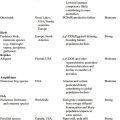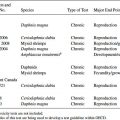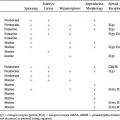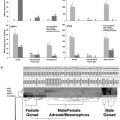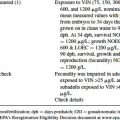Consideration of this suggested generic approach shows that EDC-sensitive and more traditional assays are closely intertwined and in some cases serve both functions. Thus, for example, fish life cycle tests are potentially the most advanced assays available, irrespective of whether they are being used to assess the apical effects of EDCs or non-EDCs. If early data in a hazard assessment, potentially including those from in silico, in vitro, bio-accumulation, and acute toxicity studies, give rise to concern about possible longer-term effects, then the first question that should be asked is whether the WoE suggests that endocrine disruption may be a factor. If the answer is no, one proceeds down the conventional route of a Fish Early Life Stage Test (FELS—OECD TG 210) or similar, which might lead on to the possibility of partial or full life cycle testing only if margins of safety are small or the bioconcentration factor (BCF) in fish is high.
If the answer is yes (i.e., there are some data pointing to endocrine activity) but the existing WoE for possible endocrine activity is only low, one should then consider the need for an EDC-specific in vivo fish screen (i.e., OECD TG 229, TG 230, or GD 148). In this scenario, a positive screen might suggest the need for partial or full life cycle testing to more completely evaluate the possible ED hazard while a negative result would then trigger a default to the FELS. Moderate WoE for endocrine activity would, however, allow the in vivo screening step to be bypassed in favor of immediate partial life cycle testing (e.g., the Fish Sexual Development Test—FSDT; OECD TG 234; or a Partial Life Cycle Reproduction Test). A negative in these tests probably would be sufficient to permit risk characterization, while a positive might in turn lead on to life cycle testing. Finally, strong suspicion of ED properties generally would lead to the immediate conduct of a life cycle test.
These choices in turn throw up a question about which type of life cycle test to use in particular circumstances, a question that cannot yet be fully answered due to relative inexperience with these assays. However, choice may be dictated by the expected mode of action (e.g., if sexual development is the primary target of the EDC, then the FSDT may be the most appropriate first choice for a longer-term assay), or by whether transgenerational effects are expected (when the MMGT may be more suitable than the FFLCT). One possible clue to the likelihood of transgenerational effects may be the bioaccumulation potential of an EDC. Those with a high BCF in fish are more likely to be passed on as harmful residues from mothers to offspring via the eggs, implying that offspring will receive greater exposure in the MMGT than the FFLCT. Another type of transgenerational effect that could be caused by some EDCs is epigenesis [15], but as with high-BCF substances, it is not yet known if chemicals with epigenetic properties will be consistently more potent in multigeneration tests.
This proposed generic testing strategy for fish is capable of elaboration by individual regulatory authorities, in order to suit their local requirements, and it will be clear that it does not obviate the need for the involvement of experts in the decision-making process. Furthermore, it will need to be expanded to include consideration of aquatic vertebrates other than fish (e.g., amphibian screening assays—OECD TG 231 with Xenopus laevis and higher-tier tests with amphibians) (see Chapter 8) as well as of certain invertebrates when a more complete range of relevant and validated assays becomes available. Life cycle tests for insects with an aquatic life stage (e.g., OECD TG 233 with Chironomus spp.) and crustaceans (a harpacticoid copepod assay with Amphiascus tenuiramis and a mysid two-generation assay with Americamysis bahia are both in development by OECD) are already a practical possibility (see Chapters 4 and 5), and similar tests with molluscs such as Potamopyrgus antipodarum and Lymnaea stagnalis are not far off [7] (see Chapter 6). However, as indicated, validated screening assays for many invertebrates are not likely to be developed any time soon due to our relatively poor understanding of their mechanistic responses to EDCs at the hormonal level. Their potential use as surrogates for ethically less desirable tests with vertebrates is not at present feasible and may never be realized.
Finally, the generic testing strategy also will need to be expanded to consider terrestrial vertebrates (other than mammals, which will have been covered in any human risk assessment), potentially including reptiles and birds. This strategy initially will be driven by consideration of whether such organisms are likely to be exposed to the test substance, but if such exposure is expected, in vivo testing with reptiles or birds may be needed. At present, there are no internationally standardized tests with either reptiles or birds that are likely to be sensitive to EDCs, and the only such assay currently under development by OECD is an avian two-generation test using the Japanese quail, Coturnix japonica. However, Chapters 9 and 10 of this book provide some pointers to possible test developments with these taxa in the future.
13.5 USE OF WEIGHT OF EVIDENCE WHEN ASSESSING POSSIBLE EDCS
Stay updated, free articles. Join our Telegram channel

Full access? Get Clinical Tree


